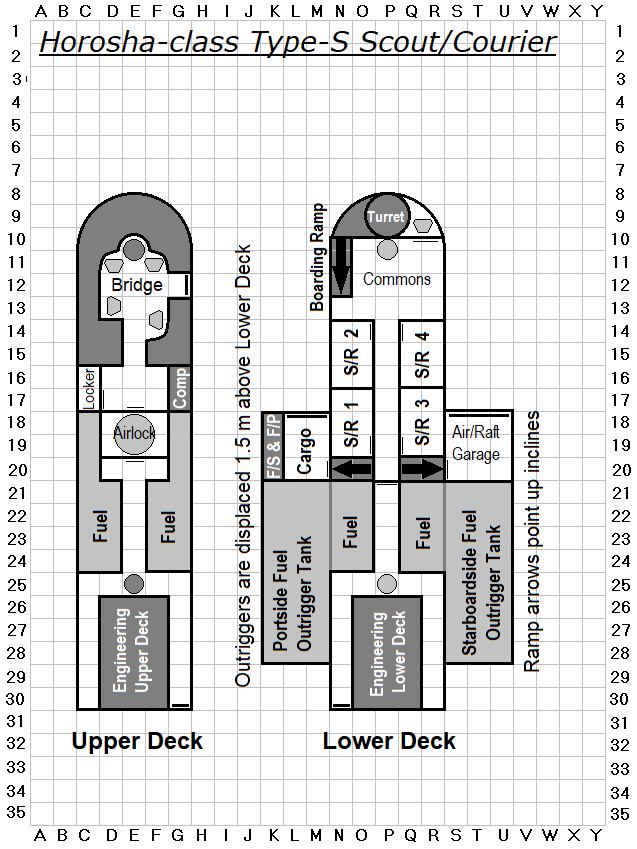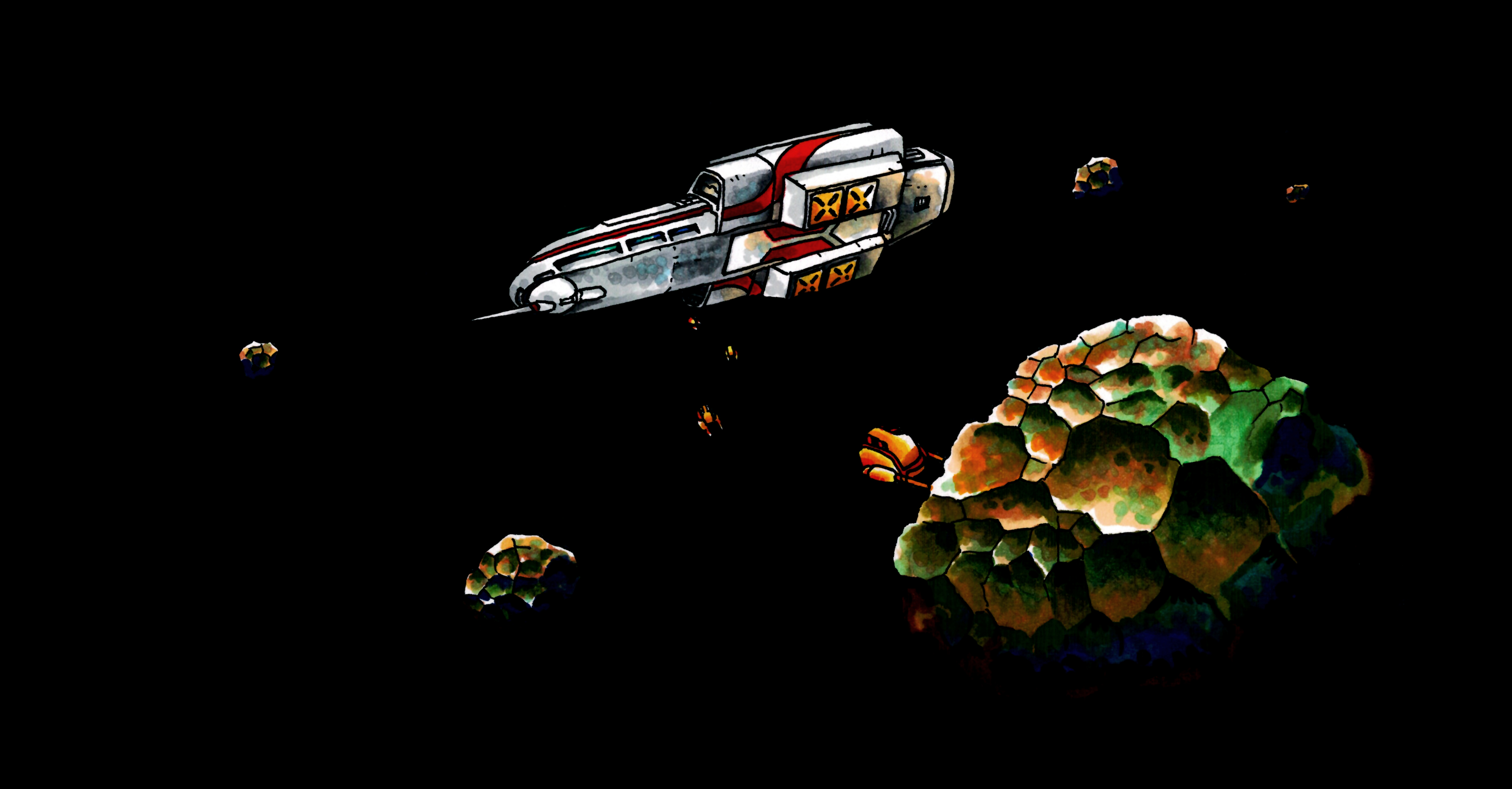Horosha-Class (Type S) Scout/Courier and Tansaki-class (Type J) Seeker
This article originally appeared in the July/August 2018 issue.
Horosha-class (Type S) Scout/Courier
Overview
The Horosha-class starship is a TL B 100 d-ton Type-S Scout/Courier that is in the process of being phased out of IISS service. Commonly seen on the fringes of Imperial space, this vessel remains a workhorse of courier duties off the ends of the X-boat routes and into backwater regions and client states of the Imperium. In the Solomani end of the empire, it is a common surplus ship (along with the familiar and aging Serpent and Suleiman classes) “loaned out” to “retired” Scouts on detached duty.
The Horosha class is highly recognizable, if inelegant, for its mid-deck outrigger fuel tank modules, top-mounted airlock and chin-mounted weapons turret. However, this modular construction shaves a month off construction times and makes the ship easily modifiable for a variety of purposes. This versatility has kept the venerable design in demand and (civilianized) production throughout Imperial and Solomani space.
Walkaround
Upper Deck
The forward part of the upper deck contains the bridge and avionics. Due to the heat put out by the older electronic components and subsystems at TL B, many ships in private service have been modified for additional life support ductwork to compensate. Those in IISS detached service typically use the utility outlets to rig up small fans to help keep cool. The hatch to the lower level provides quick access to the ship’s single weapons turret, though it is a bit of an occupational hazard as it is invariably left open – often to help compensate with the heat buildup issues in the bridge. There is also a standard boarding hatch located in the starboard side of the compartment which includes a deployable ladder and emergency docking fittings, but no airlock facilities, requiring the evacuation of the bridge if it is necessary to use this hatch in anything other than standard atmosphere conditions.
Just aft of the bridge are the ship’s locker to port and its standard Model-1bis computer to starboard. The open space between is often used by crewmembers to don and remove vacc suits for EVA.
The pass-through airlock is an unusual design feature of the class, a relic of the design’s heritage before being adopted by the IISS, which mandated a streamlined vessel. These aging non-streamlined designs still see use by belters after being converted to seeker ships. The upward hatch is roomy and permits easy docking with orbital facilities, while presenting a bit of a challenge to those attempting to board vessels of this design by force – another feature that belters can appreciate.
Continuing aft, the central corridor passes between the upper sections of the ship’s fuel tanks before entering the upper deck of the engineering section. The flooring here is a catwalk design, that has pivoting floor sections to provide easier access to the drives and power plant for repairs and maintenance. Typically, the engineer monitors the drive and power plant operations from the aft-starboard station of the bridge, only going aft when repairs or adjustments are needed. The aft-starboard hatch in this section provides an egress of the craft in an emergency (though the Engineering section will lose atmospheric integrity if this hatch needs to be used in vacuum). The floor “hatch” is actually a ladder well to the lower deck, rather than being airtight, given the floor’s construction.
Lower Deck and Outrigger Pods
At the front of the lower deck is the ship’s chin-mounted weapons turret, which is typically a double beam laser arrangement, primarily due to a lack of computer capacity and magazine volume for missile racks. Seeker conversions swap out this standard armament for a single pulse laser turret. The conditions for the fire control station adjacent to the turret are similar to those of the bridge in regard to heat buildup, but under normal combat conditions, the gunner is usually in a vacc suit and the situation isn’t as noticeable.
Aft of the turret is the ship’s commons, the port side of which holds the ship’s main boarding ramp for terrestrial landings. The ramp has a rolling door hatch that covers the opening and is airtight, but is not rated for vacuum, meaning the commons area would have to be decompressed before the ramp could be lowered under such conditions. The appointments of the commons area vary from ship to ship, but often a galley/food prep area is set up in the aft-starboard corner.
Continuing aft, the central corridor leads to the four staterooms for crew and passengers. These are somewhat cramped by most standards – even more so when flying double-occupancy – but each stateroom has complete, albeit compact, facilities for comfort and convenience. With limited space for gray water tanks and septic systems, the ship employs ultrasonic sanitizer “showers” which can also be used for laundry and the cleaning of tools and cooking utensils.
The ramps that are aft of the staterooms ascend 1.5 meters to the “floor” level of the ship’s port and starboard outrigger pods. The port pod contains the ship’s small cargo hold, through which the ship’s fuel scoop and fuel processor equipment can be accessed for maintenance and repair. The hatch to the exterior is a boarding ramp with a telescoping extender that can be used for egress in terrestrial landings, allowing the compartment to serve as an airlock in vacuum environments. The rest of the pod is fuel tankage.
The starboard outrigger pod contains the ship’s air/raft garage. The hatch to the exterior is similar to the cargo hold ramp-style hatch on the port side, allowing another option for egress from the lower deck. The rest of the pod is fuel tankage.
Continuing aft, the central corridor passes between the lower sections of the ship’s fuel tankage and into the lower deck of the engineering section. The hatch on the aft-port hull provides emergency egress; as with the similar hatch on the upper level, its uses compromises Engineering’s atmospheric integrity.
Specifications
| Horosha-Class Scout (Type S, TL B) | Tonnage | Cost (MCr) |
|---|---|---|
|
100 d-ton Standard Streamlined Hull (includes fuel scoop & fuel processor) |
- - - | 3.000 |
| Jump Drive-A (Jump-2) | 10.0 | 10.000 |
| Maneuver Drive-A (2G acceleration) | 1.0 | 4.000 |
| Power Plant-A | 4.0 | 8.000 |
| Fuel Tankage (1 × J-2 and 4 wks operation) | 40.0 | - - - |
| Bridge and Avionics (standard) | 20.0 | 0.500 |
| Model/1bis Computer (Capacity 4/0) | 1.0 | 4.000 |
| 4 Staterooms (@ MCr 0.500 each) | 16.0 | 2.000 |
|
1 Hardpoint (with fire control allocation) 1 Double Turret 2 Beam Laser (@ MCr 1.000 each) |
1.0 | 0.100 0.500 2.000 |
| Air/Raft Garage (with vehicle) | 4.0 | 0.600 |
| Cargo Hold | 3.0 | - - - |
| Components Subtotal | 100.0 | 34.700 |
| Architects’ Fee | 0.347 | |
| Base Cost | 35.047 | |
| Mass Production Discount (-10%) | -3.505 | |
| Final Cost | 31.542 |
Using a 100-ton streamlined hull, the Horosha-class Scout Courier (Type S variant) is intended for exploration, survey, and courier duties, though most have been designated surplus and assigned to detached duty with “retired” Scouts. It mounts Jump Drive A, Maneuver Drive A, and Power Plant A, giving performance of Jump 2 and 2G acceleration. Fuel tankage of 40 tons supports the power plant and one Jump-2. Adjacent to the bridge is a computer Model-1bis. There are four staterooms and no low berths. There is a single hardpoint and one ton allocated for fire control; ships of this class mount a double turret with two beam lasers. An air/raft is carried in a designated ‘garage’; the remaining three tons of space is allocated to cargo. The ship requires a crew of 1 (assuming the duties of both pilot and engineer), costs MCr31.542 (including fees and standard discounts), and takes 38 weeks to build.
Note that most Horosha-class vessels encountered with have considerable flight hours on them and can be had for 40% to 60% of the new price {[(1D/2) + 3] × 10%}. If it is one of the venerable non-streamlined models, the asking price is typically 20% to 40% of the new price for a streamlined version {[(1D/2) + 1] × 10%}.

Tansaki-class (Type J) Seeker
This is the “official” conversion of the Horosha-class starship that actually can be constructed new at most orbital construction facilities. The ship’s layout is essentially the same; the following changes have been made:
The ship’s hull is not streamlined. It retains a modified fuel scoop/fuel processor assembly, as most belters use ice planetoids, planetary ring systems and comets for fuel instead of skimming. Mined ice is placed in the modified auger feed for crushing and processing for fuel.
The ship’s double turret and beam lasers are replaced with a single turret and equipped with a mining laser (pulse laser).
The aft ten d-tons of fuel tankage in each outrigger pod is removed for ore bays. One of the main drawbacks of this configuration is that the ore bays are only accessible from the exterior of the ship. The reduction in fuel tankage means the ship can only manage jump-1 in that configuration. The ship does have standard fuel bladders that fit inside the empty ore bays to allow jump-2 operation, or for extended flights in-system to distant planetoids. Access to the ore bays is through the ramp-style hatches at their aft ends.
Specifications
| Tansaki-Class Seeker (Type J, TL B) | Tonnage | Cost (MCr) |
|---|---|---|
|
100 d-ton Standard Hull (includes ice auger & fuel processor) |
- - - | 2.000 |
| Jump Drive-A (Jump-1 in this configuration) | 10.0 | 10.000 |
| Maneuver Drive-A (2G acceleration) | 1.0 | 4.000 |
| Power Plant-A | 4.0 | 8.000 |
| Fuel Tankage (1 × J-1 and 4wks operation) | 20.0 | - - - |
| Bridge and Avionics (standard) | 20.0 | 0.500 |
| Model-1bis Computer (Capacity 4/0) | 1.0 | 4.000 |
| 4 Staterooms (@ MCr 0.500 each) | 16.0 | 2.000 |
|
1 Hardpoint (with fire control allocation) 1 Single Turret 1 Mining Laser (pulse laser) |
1.0 | 0.100 0.200 0.500 |
| Air/Raft Garage (with vehicle) | 4.0 | 0.600 |
| 2 Ore Bays (@ 10 d-tons each) | 20.0 | - - - |
| Cargo Hold | 3.0 | - - - |
| Components Subtotal | 100.0 | 31.900 |
| Architects’ Fee | 0.319 | |
| Base Cost | 32.219 | |
| Mass Production Discount (-10%) | -3.222 | |
| Final Cost | 28.997 |
Using a 100-ton hull, the Tansaki-class Seeker (Type J variant) is intended for prospecting and mining in planetoid belts and ring systems. It mounts Jump Drive A, Maneuver Drive A, and Power Plant A, giving performance of Jump 1 (due to limited fuel capacity) and 2G acceleration. Fuel tankage of 20 tons supports the power plant and one Jump-1; an additional 20 tons of space is allocated to ore bays, but may also be fitted with collapsible bladders to extend the ship’s range to Jump-2. Adjacent to the bridge is a computer Model-1bis. There are four staterooms and no low berths. There is a single hardpoint and one ton allocated for fire control; a single turret with a pulse laser is mounted, principally for mining. An air/raft is carried in a designated ‘garage’; the remaining three tons of space is allocated to miscellaneous cargo. The ship requires a crew of 1 (assuming the duties of both pilot and engineer), costs MCr28.997 (including fees and standard discounts), and takes 38 weeks to build.

 Freelance
Traveller
Freelance
Traveller